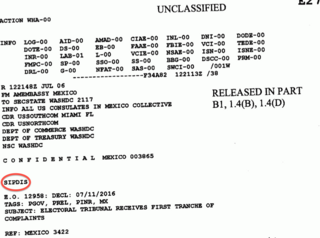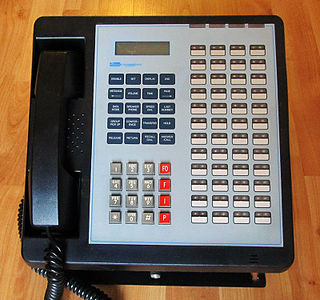The Session Initiation Protocol (SIP) is a signaling protocol used for initiating, maintaining, and terminating communication sessions that include voice, video and messaging applications. SIP is used in Internet telephony, in private IP telephone systems, as well as mobile phone calling over LTE (VoLTE).

The Defense Information Systems Agency (DISA), known as the Defense Communications Agency (DCA) until 1991, is a United States Department of Defense (DoD) combat support agency composed of military, federal civilians, and contractors. DISA provides information technology (IT) and communications support to the President, Vice President, Secretary of Defense, the military services, the combatant commands, and any individual or system contributing to the defense of the United States.
Voice over Internet Protocol (VoIP), also called IP telephony, is a method and group of technologies for voice calls, the delivery of voice communication sessions over Internet Protocol (IP) networks, such as the Internet.
The Defense Switched Network (DSN) is a primary information transfer network for the Defense Information Systems Network (DISN) of the United States Department of Defense. The DSN provides the worldwide non-secure voice, secure voice, data, facsimile, and video teleconferencing services for DOD Command and Control (C2) elements, their supporting activities engaged in logistics, personnel, engineering, and intelligence, as well as other Federal agencies.

The Secret Internet Protocol Router Network (SIPRNet) is "a system of interconnected computer networks used by the U.S. Department of Defense and the U.S. Department of State to transmit classified information by packet switching over the 'completely secure' environment". It also provides services such as hypertext document access and electronic mail. As such, SIPRNet is the DoD's classified version of the civilian Internet.
The Non-classified Internet Protocol (IP) Router Network (NIPRNet) is an IP network used to exchange unclassified information, including information subject to controls on distribution, among the private network's users. The NIPRNet also provides its users access to the Internet.
The next-generation network (NGN) is a body of key architectural changes in telecommunication core and access networks. The general idea behind the NGN is that one network transports all information and services by encapsulating these into IP packets, similar to those used on the Internet. NGNs are commonly built around the Internet Protocol, and therefore the term all IP is also sometimes used to describe the transformation of formerly telephone-centric networks toward NGN.

The Global Information Grid (GIG) is a network of information transmission and processing maintained by the United States Department of Defense. More descriptively, it is a worldwide network of information transmission, of associated processes, and of personnel serving to collect, process, safeguard, transmit, and manage this information. It is an all-encompassing communications project of the United States Department of Defense. The GIG makes this immediately available to military personnel, to those responsible for military politics, and for support personnel. It includes all infrastructure, bought or loaned, of communications, electronics, informatics, and security. It is the most visible manifestation of network-centric warfare. It is the combination of technology and human activity that enables warfighters to access information on demand.

NetOps is defined as the operational framework consisting of three essential tasks, Situational Awareness (SA), and Command & Control (C2) that the Commander (CDR) of US Strategic Command (USSTRATCOM), in coordination with DoD and Global NetOps Community, employs to operate, manage and defend the Global Information Grid (GIG) to ensure information superiority for the United States.
Joint Task Force-Global Network Operations (JTF-GNO) was a subordinate command of United States Strategic Command whose mission was to: direct the operation and defense of the Global Information Grid (GIG) across strategic, operational, and tactical boundaries in support of the US Department of Defense's full spectrum of war fighting, intelligence, and business operations.
The Defense Data Network (DDN) was a computer networking effort of the United States Department of Defense from 1983 through 1995. It was based on ARPANET technology.
The Global Information Grid Bandwidth Expansion (GIG-BE) Program was a major United States Department of Defense (DOD) net-centric transformational initiative executed by DISA. Part of the Global Information Grid project, GIG-BE created a ubiquitous "bandwidth-available" environment to improve national security intelligence, surveillance and reconnaissance, information assurance, as well as command and control. Through GIG-BE, DISA leveraged DOD's existing end-to-end information transport capabilities, significantly expanding capacity and reliability to select Joint Staff-approved locations worldwide. GIG-BE achieved Full Operational Capability (FOC) on December 20, 2005.
Global Command and Control System (GCCS) is the United States' armed forces DoD joint command and control (C2) system used to provide accurate, complete, and timely information for the operational chain of command for U.S. armed forces. "GCCS" is most often used to refer to the computer system, but actually consists of hardware, software, common procedures, appropriation, and numerous applications and interfaces that make up an "operational architecture" that provides worldwide connectivity with all levels of command. GCCS incorporates systems that provide situational awareness, support for intelligence, force planning, readiness assessment, and deployment applications that battlefield commanders require to effectively plan and execute joint military operations.
LandWarNet (LWN) is the United States Army’s contribution to the Global Information Grid (GIG) that consists of all globally interconnected, end-to-end set of Army information capabilities, associated processes, and personnel for collecting, processing, storing, disseminating, and managing information on demand supporting warfighters, policy makers, and support personnel. It includes all Army and leveraged Department of Defense (DOD)/Joint communications and computing systems and services, software, data security services, and other associated services. LandWarNet exists to enable the warfighter through Mission Command, previously described as Battle Command. Other U.S. service equivalent efforts to LandWarNet include the Navy's "FORCEnet" and the Air Force's "C2 Constellation."

The Global Broadcast Service (GBS) is a broadcast service rapidly transferring information, which may be classified, for the U.S. Department of Defense (DoD) and its deployed and garrisoned units worldwide. Information may include video and digital data. GBS has become a critical piece of the DoD's intelligence, surveillance and reconnaissance architecture. An advancement in satellite communications, GBS fills two key military communications requirements:
A variety of networks operating in special security domains handle classified information in the United States or sensitive but unclassified information, while other specialized networks are reserved specifically for unclassified use by the same agencies. Some sites accessed from these networks have been referred to as "classified websites" in official communications, such as the American embassy "Amman's Classified Web Site at http://www.state.sgov.gov/pinea/amman/" and "Mexico City's Classified Web Site at http://www.state.sgov.gov/p/wha/mexicocity" Some of these trace back to the Defense Data Network which split from the Internet in 1983.
Host Based Security System (HBSS) is the official name given to the United States Department of Defense (DOD) commercial off-the-shelf (COTS) suite of software applications used within the DOD to monitor, detect, and defend the DOD computer networks and systems. The Enterprise-wide Information Assurance and computer Network Defense Solutions Steering Group (ESSG) sponsored the acquisition of the HBSS System for use within the DOD Enterprise Network. HBSS is deployed on both the Non-Classified Internet Protocol Routed Network (NIPRNet) and Secret Internet Protocol Routed Network (SIPRNet) networks, with priority given to installing it on the NIPRNet. HBSS is based on McAfee, Inc's ePolicy Orchestrator (ePO) and other McAfee point product security applications such as Host Intrusion Prevention System (HIPS).

The Defense Red Switch Network (DRSN) is a dedicated telephone network which provides global secure communication services for the command and control structure of the United States Armed Forces. The network is maintained by the Defense Information Systems Agency (DISA) and is secured for communications up to the level of Top Secret SCI.
The Combined Enterprise Regional Information Exchange System (CENTRIXS) is a collection of classified coalition networks, called enclaves, that enable information sharing through the use of email and Web services, instant messaging or chat, the Common Operational Picture service, and Voice over IP. CENTRIXS supports combatant commands throughout the world, including the U.S. Indo-Pacific, Central and European commands.
The Joint Information Environment (JIE) is a single, joint, secure, reliable and agile command, control, communications and computing enterprise information environment to which the Department of Defense (DoD) is transitioning in a first-phase implementation that spans fiscal years 2013 and 2014.




